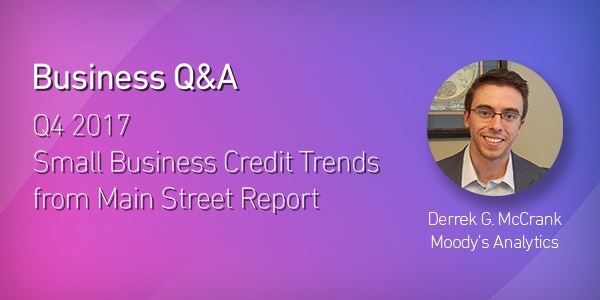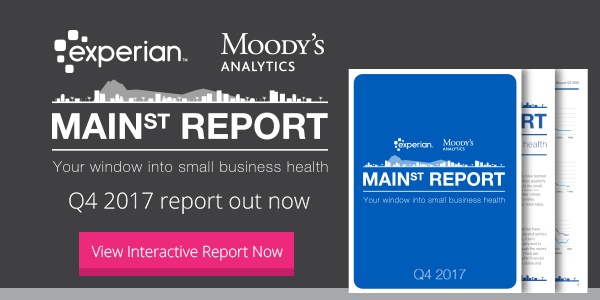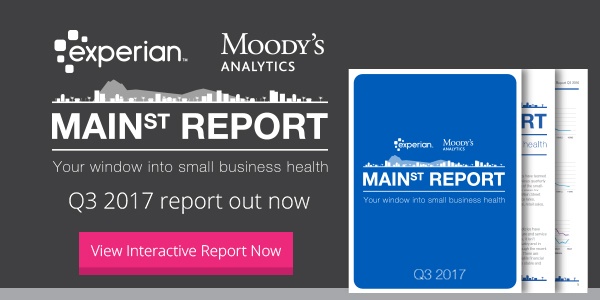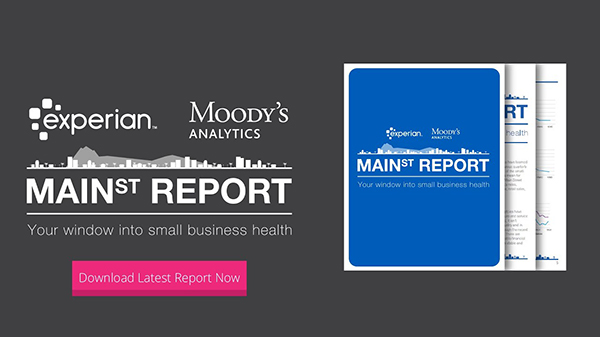Tag: Main Street Report

Click image to play the podcast This episode of the BIA Banking Strategies podcast was originally published on BAI Banking Strategies website. [Lou Carlozo]: For small businesses in 2018 the signs and indicators are complex. Bankruptcies are up, but credit conditions have finally shifted for the better. Some remain battle scarred and debt averse from the Great Recession. Yet, others see this as a time to aggressively pursue growth. How can banks make sense of these signs and take advantage of the times? To find out we'll talk with Gavin Harding Senior Business Consultant with Experian. [Lou Carlozo]: Welcome to BAI Banking Strategies where each week we'll focus on the key issues facing financial services leaders. We'll bring you objective opinions and actionable insights that will help you power smart decisions. I'm your host, Lou Carlozo, the managing editor of BAI, come on in. Don't miss our immersive annual event BAI Beacon which takes place in Orlando Florida October 9th through 11th. It takes a team to transform an organization and each team member has their own area of expertise that's critical to the effort. In the BAI Beacon, you can find the topics most relevant to your individual role and regroup at the end of the day with fresh perspective and ideas. Save 50 percent when you register before May 31. To find out more visit www.bai.org/baibeacon. [Lou Carlozo]: Thanks again for tuning into the podcast. It is great to have you here with us. And today on the program we have Gavin Harding the Senior Business Consultant with Experian Decision Analytics Global Consulting Practice. For more than half of his career Gavin held senior leadership positions with a large regional bank gaining experience in commercial and small business strategy, SBA lending, credit and risk management and sales. Gavin great to have you on the podcast today. [Gavin Harding]: Good to be here Lou. Thank you for inviting me. [Lou Carlozo]: Experian in conjunction with Moody's Analytics has this new report out the Main Street Report. Your window into small business health. So are small businesses healthy right now? [Gavin Harding]: Small businesses are very healthy right now. When you think of a small business's performance you think of it two ways one is in terms of you know revenue and overall health, and the other is in terms of access to credit how they pay their bills? For our purposes today we're thinking more about it from a lending banking perspective. From that perspective, bankruptcies are low and have been low for several quarters. Delinquencies are low and have been low for several quarters. So the fundamentals of small business are very robust very strong. [Lou Carlozo]: Small businesses are enjoying a great time. That doesn't mean of course that they're not without challenges and I'm going to read a portion of the report. Bankruptcies continued to rise in the fourth quarter making 2017 a full year in which bankruptcies increased every quarter. Taken alone this isn't good news but bankruptcies are coming off historical lows. Give us a little bit more insight as to what is going on here? [Gavin Harding]: Sure, so let's go back in time a little bit to the dreaded year 2008 when the world pretty much ended in financial terms. Massive turmoil. We tightened up credit. The whole industry worked through a series of losses. After a couple of years those portfolios were pretty well cleared out. So what was left was decent solid businesses with good fundamentals and a lot of the weak players had been essentially weeded out of the market. So time goes on, small businesses slowly start to invest but they were very leery of taking on a lot of debt but they had made it through the war. So those businesses had good credit performance. They were paying their bills and that went on for several years, and for I think it was 14 quarters. We saw that those small businesses continued to pay on time, continued to be good stewards. And then we get to 2017. [Lou Carlozo]: And then what? [Gavin Harding]: So in 2017 there was a lot of change. There had been limited investment from small business for a long time, and there is only so long that you can wait to invest. There comes a point when equipment breaks, when you need to hire people. Businesses became more optimistic. Lenders, bankers, fintech's started to open up the credit box a little bit broader standard. For 14 quarters we saw that those small businesses continued to pay on time, continued to be good stewards in terms of their investment. Good performance, very low bankruptcy levels, and then they really start to get a little optimistic a little confident, money starts to flow. We would expect that delinquencies would increase a little bit over time. We would expect that low bankruptcy rate to increase. So my perspective on that is that while it is something we should keep an eye on. It's very much an indication of growth, of confidence, of enthusiasm and investment. [Lou Carlozo]: What do you see as the most important context heading forward? [Gavin Harding]: The single most common question we have been asked over the last 18 to 24 months is when is it going to turn? And of course if we knew when it was going to turn I would be a retired multibillionaire. So the best we can do is look for indications right? and when we look for indications we look for those on a macro level, unemployment, and as we approach and reach full employment what does it do to wage growth? What does it do to access the human capital? And then we also look at it on a more micro level which is you know within our portfolio what are we seeing that's going to give us that hint? So if we start seeing instead of a gentle upward trend that we might think about in terms of a return to normality, if we start seeing for instance in our credit card portfolios for small businesses, those delinquencies spike, if we start to see those cards maxed out and delinquencies increase, that could be one of those very early signs. The other thing just keep in mind is this, the industry and when I say the industry I'm thinking about finance, over the last couple of years, has transformed in many ways. We all need to have a digital presence. We need to engage customers when they want to communicate with us. And when we need to do that with the products that they're looking for, and at the same time as we deliver this in a very slick quick way we have to maintain good solid robust risk management. And at the same time as we do all of that, we've got to make sure the fraudsters are held at bay and we minimize identity fraud and other types of fraud. So the whole industry has accelerated, it's very much now about digital technology. Customers are looking for quick and ready access. That opens all kinds of other risks for us. We're talking about integrated fraud risk. We are talking about you know advanced analytics on the portfolio. We are talking about operational risk, and our favorite kind of risk, regulatory risk, as we work to comply with regulations that are new and still evolving and haven't been tested yet. So it really is the velocity and sophistication of the industry over the last couple of years has just accelerated beyond anything I think we could have imagined. [Lou Carlozo]: I think the other consequence of this is clients sometimes getting jittery, getting nervous and one of the things that you specialize in is getting into those situations when things don't go as smoothly as a client might like, and offering some remediation, some help keeping things calm and moving forward. Tell us a little bit about how you do that work because you do it so well. [Gavin Harding]: We have clients that have either been in business a long time, or are relatively new to the space and there's often a common feature in the feature is, that they have grown many times grown rapidly, and what they had in place at the beginning was augmented and there was lots of other stuff bolted on. Prime example, banking client, regional bank, 67 separate systems and applications, none of which spoke to each other are connected. So you've got that rapid growth. You hit a certain kind of critical mass and you have to make the decision and the decision is are you going to stop assess, and identify a better way of doing things, and address all of these legacy systems and reports and legacy data and routines and processes? So in many cases working with clients we're able to stand back because we're outside right. We're outside, we know the industry, we've worked with a lot of clients but because we aren't involved in those processes day to day, we can look at them with a cold eye. We can assess them objectively against some of what we've seen other successful clients do. And in many cases, take heavily manual paper based processes and reports and decision making, and make it a lot more efficient, and by efficient, I don't mean you know automatic approvals I don't mean artificial intelligence. I mean old fashioned efficiency. So instead of doing something in ten steps can you do it in three. And when you take that analysis and you spread it across commercial lending for example, or through small business lending, there are some real opportunities to transform the process, to transform the experience of the people that have to work within the process, and ultimately to improve turnaround and accuracy the customer experience itself. [Lou Carlozo]: Turnaround accuracy. I would say this the banks and financial institutions are very fortunate to have you on their side. Gavin I want to thank you for making the time to be on the podcast today it was a real privilege. [Gavin Harding]: My pleasure. Thank you. [Lou Carlozo]: Gavin Harding is a Senior Business Consultant with Experian Decisions Analytics Global Consulting Practice. You can look for Gavin on LinkedIn. And here are three key takeaways from today's podcast: Bankruptcies are up for small businesses. In fact for four consecutive quarters in 2017 according to the Experian report. But that deserves a long view, post-recession. The small businesses that survived became very debt averse while banks tightened up lending. For small and medium sized businesses 2017 also marked a turning point to address needs such as replacing worn out equipment, or hiring badly needed staff. Some businesses haven't made it but it's nothing like the recession and it's a wave of doom. For small businesses in 2018 the news remains very positive, fundamentals are strong. Full employment is here, but there will always be potential storm clouds to keep an eye on. One is credit card delinquency spikes, another, moving too fast to address risks such as fraud. Businesses that have experienced rapid growth often suffer from bolted on systems and unconnected applications. In this case rapid growth means slowing it down. It comes down to four steps, stop, assess, identify and address. The endgame, find and implement efficiencies. [Lou Carlozo]: And now BAI Banking Strategies brings you the aha moment where our podcast guest shines a light on that point in time where realization revelation or exploration made all the difference in their financial services career. Now sometimes before you climb a mountain you've got to dig a hole and here Gavin Harding recalls how a visit from a federal regulator taught him a humbling lesson that he carries with him to this day. Listen. [Gavin Harding]: So let me take you back to Philadelphia in 1999. Being young and educated I was absolutely sure for a certainty that I knew pretty much everything I needed to know. And into that office walked a Federal Reserve auditor. He asked me a series of questions which I immediately answered, and over the course of an hour I dug a hole maybe 20 feet wide by 30 feet deep. Nice straight sides and I climbed on down into it. It took seven weeks and hundreds of files to undo the damage I did with reacting, with feeling, feeling that there had to be an answer that would be an answer now. With feeling that, as an executive, I had to have the answers. So my lesson from that experience and I keep it with me every day and it is part of every interaction with clients. First pause, and then clarify. So make room to think, understand that I didn't have to give an answer. Understand that "I'll get back to you" was a much better answer than a whole series of statements that may or may not have been connected, and were not thought out and were not researched. So I am greatly appreciative to the Federal Reserve for training me in 1999 in Philadelphia. This episode of the BIA Banking Strategies podcast was originally published on BAI Banking Strategies.

Gary Stockton: Experian has just released the Q4 2017 Main Street Report. We partner with Moody's Analytics on this report each quarter, and Derrek Grunfelder-McCrank is the economist who works on the report. We asked him a few questions about the trends that we're seeing in this quarter's data. Gary Stockton: The latest Main Street Report states that small business credit conditions remain positive. Is there a primary factor that's driving this stability? Derrek G. McCrank: Yeah there certainly is Gary. The primary factor that's driving stability in small business credit is the broader U.S. economy. Right now we have the labor market that's tight. This is resulting in wage increases for consumers as a result. Consumer spending has been reliable. Inflation is starting to pick up in a slow steady manner. On top of it all at the end of last year we just got tax reform. Right now the outlook for small business credit is positive. And that doesn't look set to change anytime soon. Gary Stockton: and are you seeing greater numbers of small businesses investing in that business by borrowing for equipment purchases? Derrek G. McCrank: Well Gary while we can't say for certain. The data seems to suggest that this isn't happening to the extent it could just yet. One of the questions in the NFIB's monthly survey is about whether firms are planning capital expenditures in the next three to six months. Since the end of the last recession. We've seen the positive response rate to this question steadily increasing. However it still sits below its long term average. Couple this with tax reform coming so late at the end of last year, and a decent number of firms are likely to have waited until the new year when they could invest in their business with a little more certainty. Gary Stockton: Well historically small businesses been keeping bankruptcy in check, but this quarter we saw it up slightly. Is this a major concern? Derrek G. McCrank: This isn't a cause for concern yet. Though it is something to monitor going forward. In the first quarter of 2017 the small business bankruptcy rate bottomed out, it hi its floor. As the year progressed, the bankruptcy rate moved off of that floor and that appears to be all that happened. In fact I'm hopeful that this might indicate a return to a more dynamic environment for small businesses which I look forward to discussing in a little more detail and our upcoming webinar. But for now, given the state of the economy, I'm optimistic for the state of small business credit. Gary Stockton: On the flip side, the Northeast saw a steep decline in business bankruptcies in Q4. Can you share some insight on what might be driving that? Derrek G. McCrank: Sure, so in the fourth quarter. the Northeast saw declines in its severely delinquent or 90 days past due rate coupled with a slight uptick in its business bankruptcy rate. What happened with business bankruptcies mirrored the trend nationally, so it shouldn't be a cause for concern this year, the declines in the severely delinquent rate were driven by two primary factors - geography and industry, from a geographic point of view, Connecticut, New Hampshire and Maine were the driving forces behind the reductions in severe delinquency, and from an industrial point of view financial services, public administration and the manufacturing industries are credited with declines in severe delinquency. Download the latest report

Experian and Moody’s Analytics just released the latest Experian/Moody’s Analytics Main Street Report for Q4 2017. The report brings deep insight into the overall financial well-being of the small-business landscape, as well as providing commentary around what certain trends mean for credit grantors and the small-business community. The overall outlook for small-business credit is positive. Outstanding balances rose in the fourth quarter, as did the average balance outstanding per business. Delinquency and default rates rose slightly, suggesting that credit conditions have loosened. Continuing strength in the macroeconomy will keep small businesses moving in the near term, along with higher profits from the recently passed tax legislation. Small-business credit will be less certain in the medium to long term as rising wages and tax code changes take a toll. Northeast sees the steepest decline in delinquency The Northeast saw the steepest decline in severe delinquencies in the fourth quarter, and construction was one of the industries responsible for that trend. Many small construction firms have a focus on residential projects, making consumer credit growth an ideal metric to use as a basis for understanding what’s happening and what will happen in the industry. We have published the entire contents of the report in an interactive page, complete with charts and graphs. Download Main Street Report

Experian has just released the Q3 2017 Experian/Moody's Analytics Main Street report and the overall outlook for small-business credit is stable. The report states outstanding balances on small-business credit declined slightly in the third quarter, continuing a two-year trend. Delinquency and default rates were steady to declining, and business balance sheets continue to improve. Continued improvement in the labor market and economic growth bodes well for credit performance in the short term. Despite the overall optimism, pockets of localized weakness are developing and will warrant observation over the next few quarters. “Small business credit conditions are good and steadily getting better. Businesses are paying on their obligations in an increasingly timely way and remain cautious in their new borrowing. There are some credit problems in different parts of the country in various industries, but they are few and far between.” Mark Zandi, Chief Economist, Moody's Analytics An expanding economy supports credit performance As small businesses continued to keep credit utilization low, paying down debt, delinquencies overall continued to trend downward. Early-stage delinquency rates improved during the quarter while the 90 days past due (DPD) delinquency rate experienced a slight 5 basis point increase. The most severe delinquency category, 91+ days past due, declined as some distressed credit was charged-off. The decline in late-stage delinquency was offset somewhat by an increase in bankruptcy rates. While the report contained mostly good news, there were a few surprises, including Wyoming, which saw a slight increase in 90-days past due delinquency in mining, construction, transportation and retail, pushing the state’s delinquency rate by almost half a percentage point. We have put the entire contents of the Experian/Moody’s Analytics Main Street Report into an interactive page, complete with dynamic charts.

Experian and Moody's Analytics have just released the Q2 2017 Main Street Report. Developed by Experian and Moody’s Analytics, the Experian/Moody’s Analytics Main Street Report brings deep insight into the overall financial well-being of the small-business landscape, as well as providing commentary around what certain trends mean for credit grantors and the small-business community. Q2 highlights Small-business delinquency rates experienced broad-based improvement in the second quarter. With job growth expected to continue, putting more money in consumers’ pockets, small businesses will continue to outperform in the short term. As performance on small-business loans and lines of credit improves, credit is expected to flow more freely as banks and other lenders compete for business. Although tax reform and infrastructure investment could provide an additional boost to small-business activity, consumer spending will be the driving force for small-business credit over the next quarter — and throughout the rest of the year. Business delinquencies push lower Small-business delinquencies continued to trend downward in the second quarter. Both early- and late-stage delinquency rates saw improvement over the quarter. This trend has been firmly in place over the last two years and was expected given the continued slow but steady growth in the economy. Download Main Street Report

Experian has released the latest quarterly report on business credit conditions and things are looking very positive. According to the Experian/Moody’s Analytics Main Street Report, credit utilization rates expanded strongly in the first quarter of 2017. Results from the latest Experian/Moody’s Analytics Main Street Report, were presented today during Experian’s Vision Conference. The latest report shows small-business confidence levels eroding however; even though the data reveals their credit performance is going well, with steady declines in delinquencies and increases in credit balances, limits and utilization rates. Latest Experian/Moody's Analytics Main Street Report Reveals Strong Business Credit Conditions - Click to Tweet According to the economists at Moody's, small businesses started the year on a positive note with a decline in early delinquencies (less than 30 days past due) and severe delinquencies (more than 90 days past due). We also saw single-digit gains in credit balances (up 8.8 percent) driven by strong credit utilization rates, while credit limits increased by 4.5 percent. “The market performance data and insights on trends help our small businesses and lenders make more informed decisions,” said Gavin Harding, senior business consultant for Experian. “So while we see that delinquencies are declining and credit limits and utilization rates among small-businesses owners are increasing, we also understand that small businesses don’t have adequate credit to expand at their desired pace. If economic conditions continue to improve this year, we should see financial institutions start to increase credit availability for small-business owners.” Agriculture stands out as an industry bright point, despite four years of declining income for farmers. Performance in the manufacturing, transportation and public administration industries, however, wasn’t as strong. Other sections in the Q1 2017 report include a detailed analysis of: Small-business risk assessment strategies States ranked by their rate of severe delinquency Potential impacts from policy changes Credit quality in different industries A forecasted outlook for the coming months

Today Experian released the Q4 2016 Experian/Moody's Analytics Main Street Report. The report offers deep insight into the overall financial well-being of the small-business landscape, as well as providing commentary around what certain trends mean for credit grantors and the small-business community as a whole. Delinquency Rates Decline Sharply Small business delinquency rates fell throughout 2016 at a slower pace compared to 2015. Q4 saw a sharp decline in delinquency across multiple industry sectors. Oil pricing may be what's drivingThis was likely due in part to OPEC's announcement to cut supply over the next several months. Small Businesses Feeling Confident as Balances Increase Q4 loan balances increasing 7.7 percent from the third quarter and 10.3 percent from last year. Despite this activity, utilization remains below 40 percent, leaving plenty of capacity for businesses to expand using available credit. Business sentiment among business owners remains positive with the National Federation of Independent Business Owners reporting a sharp increase in small-business owner confidence in November and December. Nevada Roars Back Nevada was particularly hard-hit during the Great Recession. Small businesses in the state have struggled with credit ever since. In the fourth quarter Nevada's severe delinquency rate fell to 8.94 percent, the lowest level observed in the available history for the state. Eight of eleven industries in Nevada saw delinquency rates decline from the third quarter of 2016. Experian has published the contents of our report in an interactive web page, complete with interactive charts and graphs.

Latest Main Street Report findings offer cautious optimism as small business bankruptcy rates and delinquencies decline Experian has released the Q2 2016 Experian/Moody's Analytics Main Street report. The report offers a unique quarterly snapshot into the health of small business credit in the United States. The report states current credit conditions for small businesses are improving across most of the country. Overall small-business delinquencies decreased slightly from last quarter, with dropping levels in every stage of delinquency. The total bankruptcy rate fell as well, although at a slower pace than the previous year. "Small business owners have done a great job of managing their financial commitments and paying their bills on time over the past few quarters. This has led to an increased level of available capital which could enable them to expand or invest in their business to grow their enterprise. It will be very interesting, however, to watch the current trends unfold throughout the rest of the year as administration and potential policy changes, as well as the impact of Brexit and other global events could affect U.S. business behavior." Gavin Harding Sr. Business Consultant, Experian "Small businesses are doing well, and their near-term prospects are good. Delinquencies and bankruptcies are steadily declining, reflecting solid sales, low interest rates, and generally light debt loads. The only blemish is for businesses in the still struggling energy and related industries." Mark Zandi Chief Economist, Moody's Analytics While current conditions enable small businesses to have an abundance of credit available to them, the average utilization rate was down almost 22 percent from the same period in 2015. The report found that this decline is the result of a slight increase in credit limits and a steady increase in balances. Other Q2 2016 highlights: The mining industry experienced the sharpest increase in severe delinquencies and bankruptcies across all industries in the second quarter. The transportation and utility industries also experienced a decline, with the average severe delinquency rate increasing by 30 basis points during the quarter. Construction has seen the strongest improvement, with severe delinquencies dropping by nearly one third in the last year and a half. Construction bankruptcy rates, however, remain high in West Virginia and New Mexico, with rates of 0.59 percent and 0.44 percent, respectively. Bankruptcy rates along the Eastern Seaboard tend to be below the national average. About the Experian/Moody's Analytics Main Street Report Developed by Experian and Moody’s Analytics, the Experian/Moody’s Analytics Main Street Report brings deep insight into the overall financial well-being of the small-business landscape, as well as provides commentary around what certain trends mean for credit grantors and the small-business community as a whole. Key factors comprised by the Main Street Report include a combination of business credit data (credit balances, delinquency rates, utilization rates, etc.) and macroeconomic information (employment rates, income, retail sales, investments, etc.)

Experian Business Information Services and Moody’s Analytics have joined forces to develop the Experian/Moody’s Analytics Main Street Report. The report leverages a combination of business credit data (including credit balances, delinquency rates and utilization rates) and macroeconomic data (including employment rates, income, retail sales and investments) to provide a more accurate assessment of the health of small businesses. Small businesses are the engine of the U.S. economy - employing the majority of U.S. workers, so with this quarterly report Experian seeks to provide a unique view into the health of those small businesses, offering a benchmark on their overall financial health, and emerging trends across major industry sectors. “Gaining deeper insight into the health of small businesses is important for credit-granting organizations, as well as the small-business owner. While credit grantors can leverage the information to make more profitable financial decisions, small-business owners can better understand the fluctuations in their industry and region. By working with Moody’s Analytics, we are able to combine our expertise and data resources to deliver a more holistic view of the trends impacting the business community in particular and the economy overall.” Gavin Harding, Sr. Business Consultant Experian, Global Consulting Practice Q1 2016 highlights The first quarter 2016 report shows that credit conditions for small businesses have remained relatively stable, as delinquency and bankruptcy rates hold steady at low levels. In fact, much of the slight decrease in delinquencies was driven by fewer small businesses falling within the 61 to 90 and 91+ days past due categories. Additionally, the Q1 2016 report shows that small businesses have begun to expand their credit lines while keeping their utilization rates down. Through a combination of the increase in credit availability and small gains in balances, the average credit utilization for a small business dropped nearly 17 percent from the previous year. “Small business credit conditions continue to improve, and near-term prospects are good. Delinquencies and bankruptcies have declined in most industries and regions of the country for more than a year. The energy industry is the only exception. There are threats to the positive small business credit outlook, including prospects for rising interest rates and volatile financial markets, but those threats appear modest.” Mark Zandi, Chief Economist Moody's Analytics Other Q1 2016 findings: Despite a strong economic performance relative to the rest of the country over the past several years, bankruptcy rates were elevated in the Southwest and the West Delinquency rates for the retail industry ticked up slightly during the first quarter of 2016 as a result of weak retail sales The top three states with the highest average business credit score* were Vermont (62.6), North Dakota (61.8) and South Dakota (61.7) Download Main Street Report
